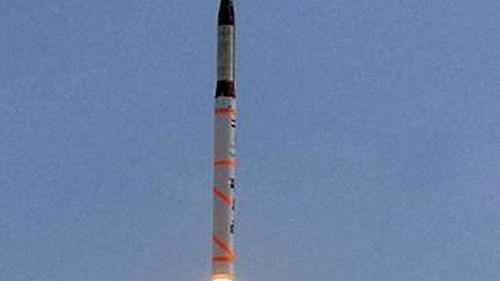
India successfully test-fired an Intermediate Range Ballistic Missile, Agni-4, from the Integrated Test Range in Chandipur off the Odisha coast, defence sources said.
Credit: PTI file photo
The Defence Ministry on Friday said that India has successfully test-fired an Intermediate Range Ballistic Missile, Agni-IV, from the Integrated Test Range in Chandipur off the Odisha coast.
The launch successfully validated all operational and technical parameters.
It was conducted under the aegis of the Strategic Forces Command, news agency PTI reported.
Here are ten things you need to know about the long range surface-to-surface missile.
Fourth in the Agni series
As evident from the name itself, Agni-IV is fourth in the Agni series of medium to intercontinental range ballistic missiles developed by the Defence Research and Development Organisation (DRDO). The name comes from Sanskrit word 'Agni', which means 'fire' and represents one of the five elements of nature.
Working
Lighter in weight with two stages of solid propulsion and a payload with re-entry heat shield, the Agni-IV represents many firsts in India's missile technology.
Range
The missile has a range of 4,000 km, which makes it an Intermediate Range Ballistic Missile (IRBM). This means that if the missile is launched from northeast India, it will be capable of striking targets in nearly all of mainland China.
Performance and reliability
Agni-IV uses Composite Rocket Motor for the first time. This has given it excellent performance. The electronic systems used in the missile are modern and compact, providing a high level of reliability.
Length, weight
The Agni-IV missile has a length of 20 metres and weighs 17 tonnes (15.4 thousand kilograms).
Payload
It can carry a payload of 800 kg. The missile can carry both conventional and nuclear warheads.
Accuracy
The Agni-IV uses indigenous-built ring laser gyroscope with Micro Inertial Navigation System (MINGS). These technologies have enabled the missile to hit within 100 metres of its target.
Guidance
Agni-IV has a full Digital Control System and a powerful onboard computer system for its guidance. It is equipped with flex nozzle control (FNC) thrust vectoring control systems to maintain precise orientation during flight.
Launch
Being a surface-to-surface missile, Agni-IV can be launched from a road-mobile launcher or an 8×8 transporter erector launcher. A surface-to-surface missile or SSM is designed to be launched from ground or sea to hit targets on ground or sea.
Tests
Agni-IV has undergone seven successful test fires over a span of six years, with the first one being conducted in November 15, 2011. The recent test fire was conducted on Friday.